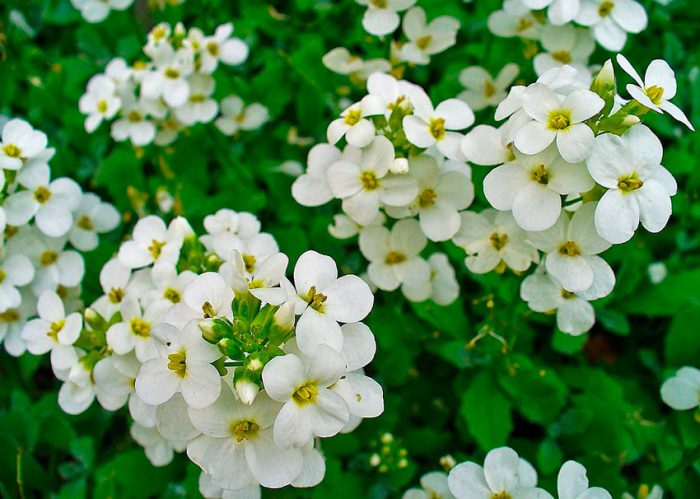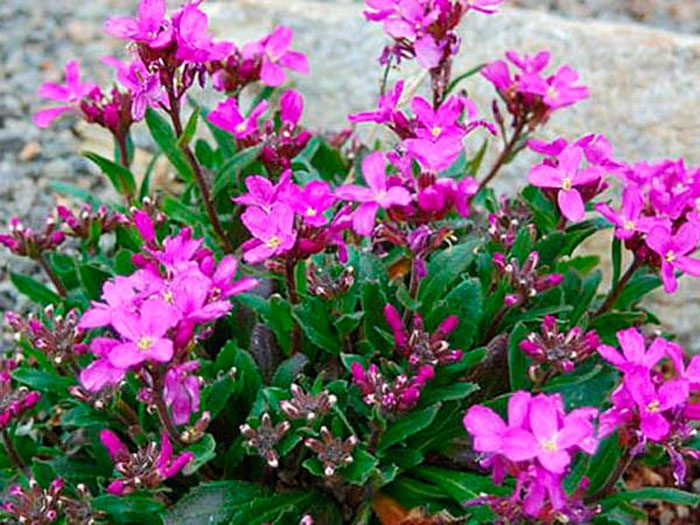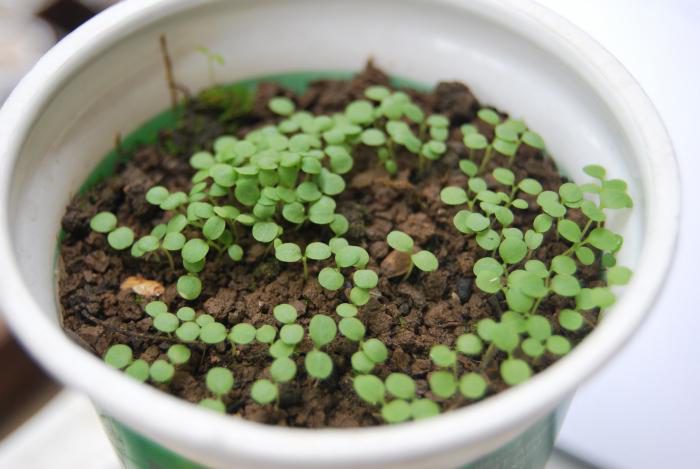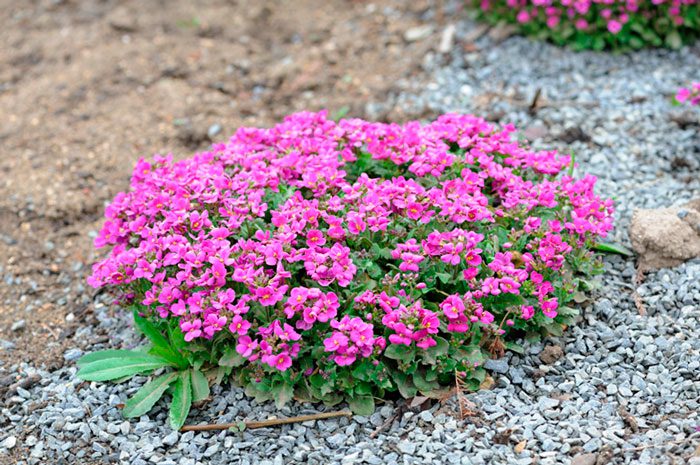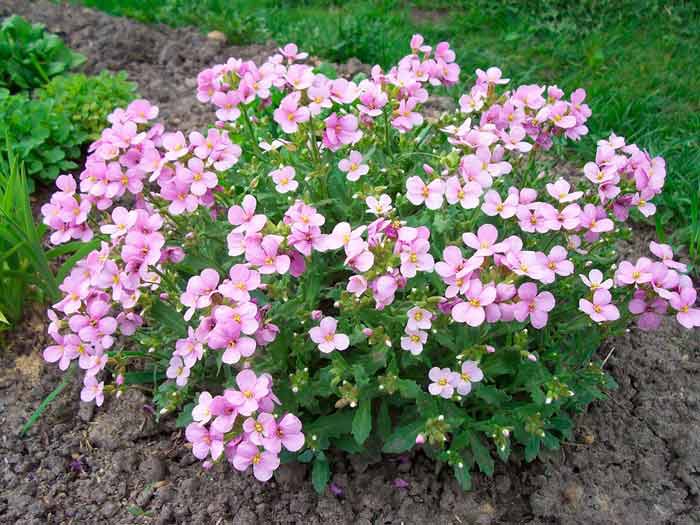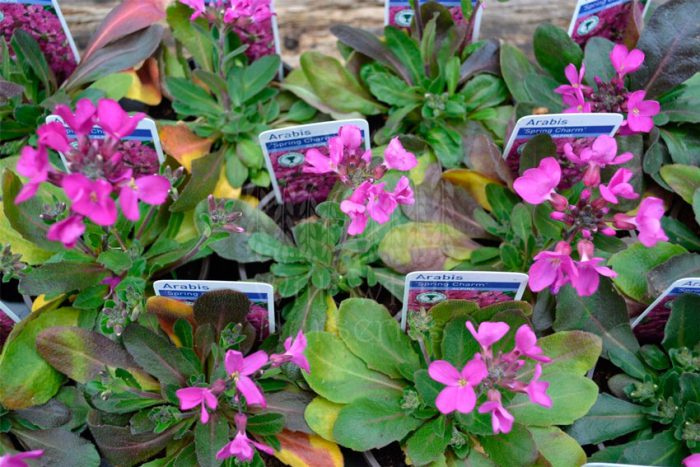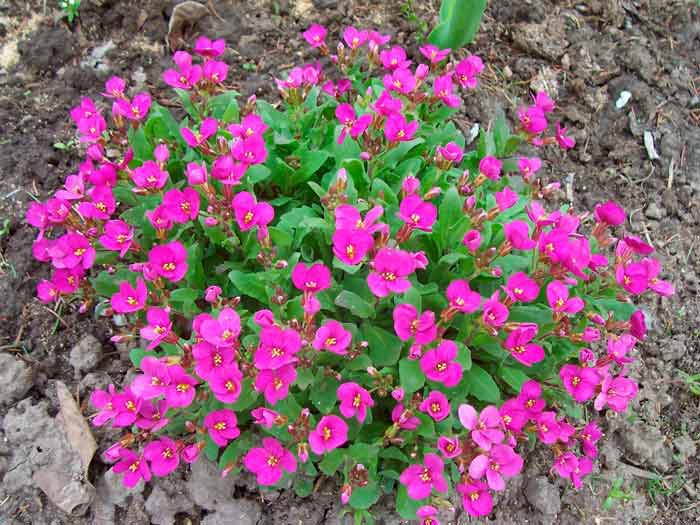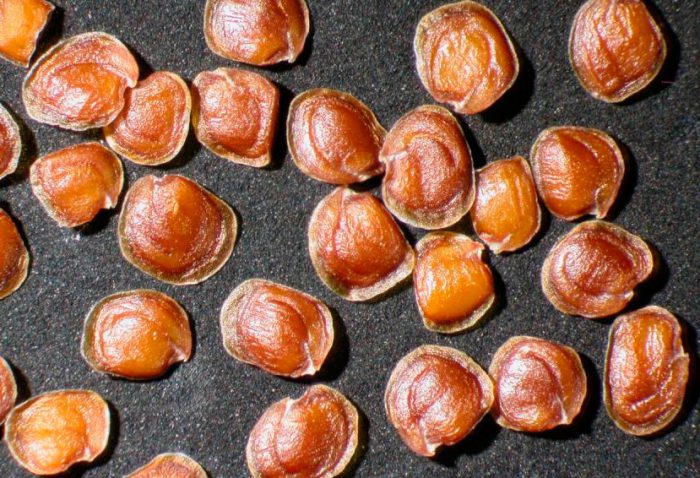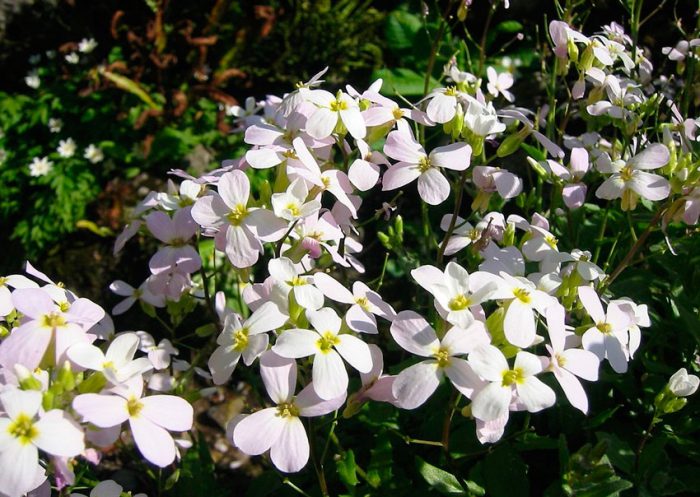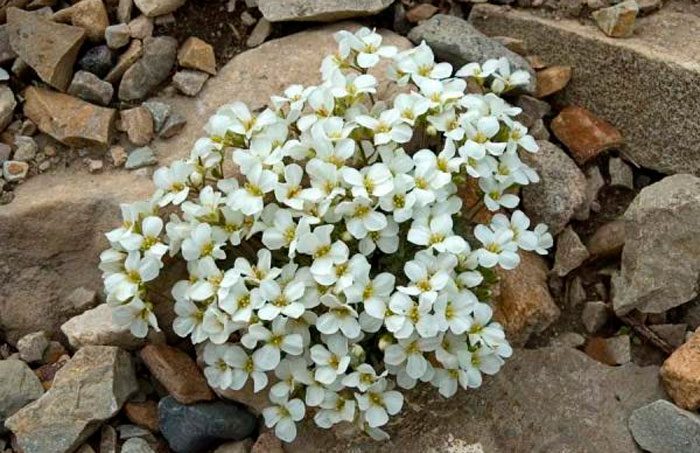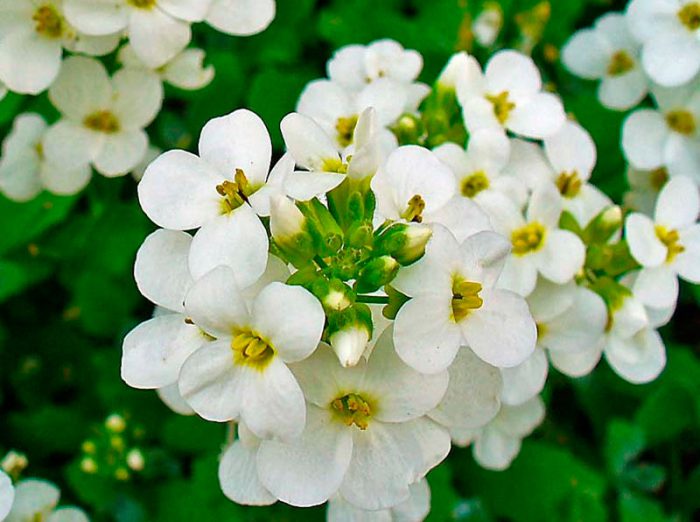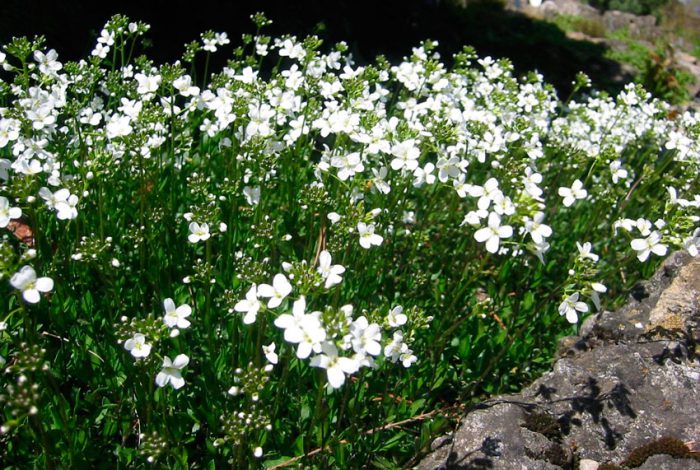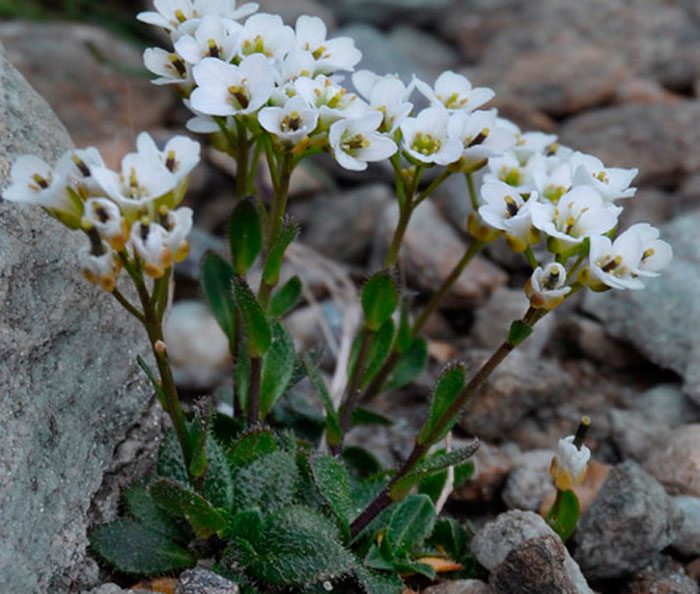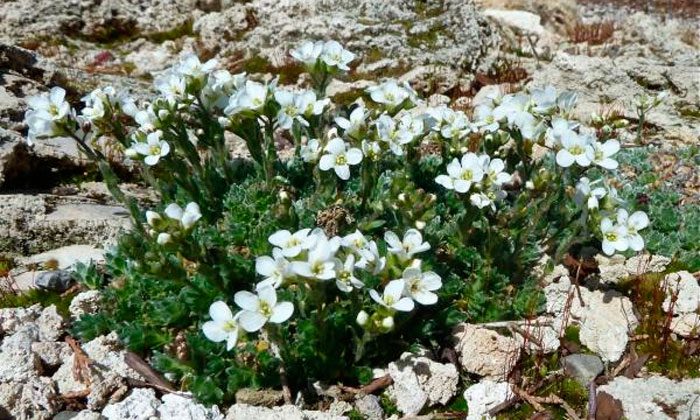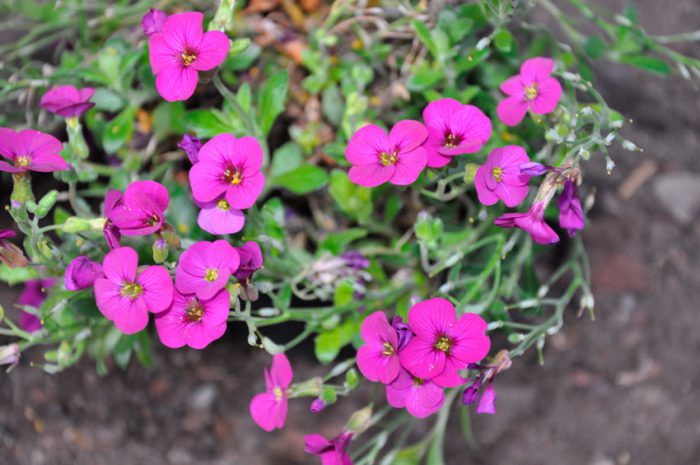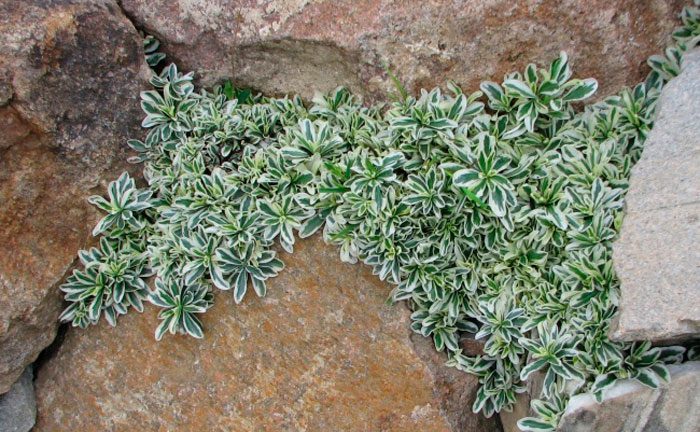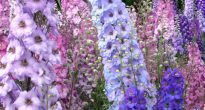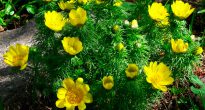The perennial herb Arabis, also called rezuha, is a member of the cruciferous or cabbage family. This genus includes more than 100 species. In the wild, such a plant can be found in areas with a temperate climate in the Northern Hemisphere, as well as in the mountains of tropical Africa. It is not clear exactly how and where the Latin name of this plant came from. Razuhy, however, it is called because the bush is covered with tough hairs, about which you can easily get hurt. Arabis has been cultivated for more than two centuries. In landscape design, these flowers are used to decorate flower beds and mixborders, as well as ridges, borders and alpine slides.
Content
Features of Arabis
Arabis is cultivated as an annual or perennial. It is used as a ground cover plant, as it has creeping rooting shoots. The height of the bush does not exceed 0.3 meters. On the surface of green leaf plates there is a dense pubescence, their shape is cordate, they are solid, sometimes with a serrated edge. Not very large dense racemose inflorescences consist of double or simple flowers, reaching 15 mm in diameter, they can be painted in white, light yellow, pink or purple. The abundant flowering of the plant is relatively long, and it begins around the middle of spring. A very pleasant smell emanates from the inflorescences, which attracts a large number of bees to the garden. The fruit is a pod with flat-shaped seeds inside. There are species with winged seeds. This plant is related to horseradish, cabbage, iberis, alissum, colza, mustard, radish and other representatives of the cruciferous family. It not only has a pungent odor, but is also unpretentious to growing conditions.
Growing Arabis from seeds
Sowing
Arabis is very easy and simple to grow from seeds, which can be bought in specialty stores, garden centers or at flower exhibitions. Sowing seeds can be done directly in open soil before winter in October. Also, razuha can be grown through seedlings, in this case, you need to sow seeds in April. To do this, fill containers or boxes with a soil mixture consisting of garden soil and small stones or sand (3: 1). The seeds need to be buried in the substrate only half a centimeter, then the container is placed in a place where the air temperature is about 20 degrees. To increase seed germination, the container must be covered with a non-woven material, for example, agrospan.
Growing seedlings
After 3–3.5 weeks after the seedlings appear, the shelter is removed, while watering must be reduced. Transfer the seedlings to a warm and well-lit place. Caring for these seedlings will not be difficult. It only needs to be watered when necessary, and also systematically gently loosen the surface of the substrate.
Picking
When the seedlings have the first true leaf plate, it is necessary to make a pick, but only if you are going to grow rezuha as a separate plant. To do this, the plant is dived into individual cups or seated at a distance of at least 0.3 m. In the event that you intend to use this flower as a ground cover plant, then you do not need to dive it. 10–12 days before transplanting arabis into open soil, you need to harden it. For this, the plants are transferred to the street every day, while the duration of the hardening procedures must be increased gradually. When the seedlings are outdoors, provide them with reliable protection from drafts. After the plants are fully adapted to the new conditions, they can be planted in open soil.
Planting Arabis in open ground
What time to plant
Planting seedlings in open soil should be done in the last days of May or the first days in June, but it should be borne in mind that the plants must have at least three true leaf plates. The best site for planting a rezuh will be one that is well lit and blown by the wind. However, it can be planted in a shaded place, but it should be borne in mind that in this case, the flowering of the bushes will be less abundant, and they will not grow very much.
How to land correctly
The soil suitable for planting should be sandy, loose, not very wet, saturated with mineral and organic substances, free from weeds and carefully processed. To improve the air and moisture permeability of the soil, it is recommended to add small pebbles, sand and sod to it. However, if you grow Arabis in poor acidic or calcified soil, then it will not die, but it will not grow very much. The scheme of planting seedlings is 0.4x0.4 m.In one hole, you can plant 3 or 4 plants at once. The planted rezuha needs abundant watering. In the event that the soil was not fertilized before planting, then 1-2 days after this procedure, be sure to feed the plant with complex mineral fertilizer. The first flowering can be seen only in the second year of life.
Caring for Arabis in the garden
Razuha must be cared for in the same way as most common garden plants. It is required to water, weed, feed, cut in a timely manner, and also to loosen the surface of the site and monitor health. Such a flower is drought tolerant, and it is better to underfill than overflow. This means that watering should be arranged only when there is a prolonged dry period. Remember to water in moderation.
Arabis at the beginning of his life needs to ensure freedom from weeds, this requires frequent weeding. However, over time, the flower will get stronger, and will itself "crush" the weeds.Fast growing stems need to be pruned systematically to keep the shape of the plant neat. Timely removal of the flowers that have begun to fade promotes longer flowering.
Reproduction of Arabis
Razuha can be propagated by seeds, and also by such vegetative methods as: layering, cuttings and dividing the bush. The cultivation of this flower from seeds is described in great detail above. Cuttings can be propagated by terry or rather rare varieties of rezuhi. In this case, the stalk is a leaf blade with a heel, which is part of the cambial layer. Roots will grow from this layer. To get the "correct" cutting, you should tear off the leaf plate from the bush with a guy so that part of the shoot bark with the subcortex pulp is separated with it. Cuttings are harvested at the end of flowering. If desired, you can take the upper part of the stem as a cutting, its length should be 10 centimeters, while all the leaf plates located below should be cut off from it. The cuttings are planted in a loose soil mixture at an angle, then the container must be covered with a cap, which should be transparent. The resulting mini-greenhouse should be placed in a well-lit place, which should be protected from direct sunlight. The soil should be constantly slightly damp. Cuttings also need systematic ventilation, and condensation must also be removed from the surface of the shelter. After the turgor of the upper leaf plates is restored, it will be possible to start transplanting cuttings into the garden.
To obtain a layering, you should choose a strong stem and bend it to the surface of the site. Fix this stem in this position in the area of the leaf node and do not forget to pinch the top. After young roots grow from the leaf node, the cuttings can be cut off from the mother bush and planted in a permanent place.
If you grow a terry or the rarest variety of arabis, then in this case it is recommended to propagate it by dividing the bush. Remove the bush from the soil, divide it into several parts, which you plant in new permanent places. To propagate the flower in this way is recommended only at the end of flowering.
Transfer
It is possible to propagate rezuha by dividing the bush without removing it from the soil. To do this, it is necessary to pin its shoots to the surface of the site and wait for the roots to grow from the leaf nodes. Then the cuttings are separated from the parent bush. They will need to be divided into segments according to the number of root bundles. Then they are seated in their permanent places.
Diseases and pests
Rezuha is highly resistant to various diseases and pests. However, very rarely, she can get sick with a viral mosaic or a cruciferous flea can settle on it. If small specks of brown color appear on the surface of the leaf plates, which grow over time until they merge with each other, this indicates that the plant is infected with a viral mosaic. This specimen cannot be cured, so it must be removed from the ground and destroyed. The area where the infected flower grew must be shed with a strong solution of potassium manganese. Nothing can be grown on this site for at least 1 year.
If a cruciferous flea has settled on the bushes, then dusting them with wood ash will be an ineffective and rather labor-intensive procedure. In such cases, it is recommended to spray the bushes with Aktara, Karbofos, Aktellik, Biotlin or Iskra.
Arabis after flowering
Seed collection
When the razuha blooms, you need to choose the most spectacular inflorescences and outline them. After the first frost, it will be possible to start collecting seeds, for this a dry sunny day is chosen. The fact is that if you collect seeds on a rainy day, they will have a relatively low germination rate. First you need to cut off the inflorescences with part of the shoot.They are hung in a well-ventilated room and allowed to dry. Then the seeds are removed from the inflorescences and placed in a cardboard box, which is stored in a dry, dark place.
Preparation for wintering
Without shelter, such a flower can withstand temperatures down to minus 5-7 degrees. If the air temperature drops even lower, this will lead to the death of the uncovered Arabis. With the onset of frost, it is necessary to trim the stems, while on the surface their segments of 20–40 mm in length should remain. Then the site is covered with a layer of dried foliage, or you can cover it with a covering material or spruce branches.
Types and varieties of arabis with photos and names
Below will be described those species and varieties that are most popular with gardeners.
Alpine Arabis (Arabis alpina = Arabis flaviflora)
Under natural conditions, this species can be found in the northern part of Scandinavia, in the highlands of Western Europe and North America, as well as in the Far East and the Polar Urals. The height of such a perennial plant can reach 0.35 meters. Generative stems are ascending, and loop-like vegetative ones are pressed to the soil, they branch strongly, do not die off in winter and form cushion-like clumps. The shape of the stem leaf plates is heart-arrow-shaped, and the basal ones are oval. The length of racemose inflorescences is about 50 mm, they consist of fragrant flowers with a diameter of 10 mm, which can be painted white or pink. Flowering begins in April and lasts approximately 4 weeks. Garden forms:
- Schneeshaube... The height of the bush does not exceed 0.25 m. The length of racemose inflorescences is about 15 centimeters, they consist of large (diameter 20 mm) white flowers.
- Terry... The inflorescences are larger than the original species, and they are also similar to levkoy.
- Pink... The height of the bush does not exceed 0.2 meters. The length of the inflorescences is about 12 centimeters, they include pink flowers, up to 20 millimeters in diameter.
The above tells about the planting and care of Alpine Arabis.
Arabis bryoides
The homeland of such a plant is the alpine and subalpine belt of the mountainous regions of Greece, Albania and Bulgaria. This perennial plant, which has a pillow-like shape, reaches a height of about 10 centimeters. On the surface of small oval-shaped ciliate leaf plates, there is a tomentose pubescence, they are collected in rosettes. Loose corymbose inflorescences consist of 3-6 white flowers.
Caucasian Arabis (Arabis caucasica)
According to some scientists, this plant is a subspecies of Alpine Arabis. Under natural conditions, it can be found in the Crimea, Asia Minor and Central, the Caucasus and the Mediterranean. During the flowering period, the height of this perennial plant can reach up to 0.3 m. Small oblong leaf plates with large teeth along the edge on the surface have dense white pubescence, from which their color looks like a greenish-gray. The racemose inflorescences reach 8 centimeters in length, they consist of white flowers, the diameter of which is 15 mm. Flowering begins in June and lasts 4 weeks. However, individual flowers can bloom on the bush until autumn. The fruit is a narrow long lump. Cultivated since 1800. Garden forms:
- Flore Pleno... Lush flowering, white double flowers are located on long peduncles.
- Variegata... On the edge, the leaf plates are light yellow.
- Rosabella... The color of the flowers is pink.
Arabis running out (Arabis procurrens)
In nature, this species grows in the Balkans. The height of such a ground cover plant is about 12 centimeters. There are small leafy rosettes and pale flowers. Often this type is used to secure sliding slopes. This species is distinguished by its unpretentiousness and frost resistance, but at the same time it is recommended to cover it for the winter.The most popular variety is Variegata: green leaf plates have a wide white border, purple flowers are collected in a bunch, their color changes to white over time.
Undersized Arabis (Arabis pumila)
In the wild, such a plant can be found in the Alps and Apennines. The height of the bush is about 15 centimeters. Unsightly flowers are white. Flowering begins in May or June. In this species, not flowers are decorative, but fruits, thanks to which gardeners grow it.
Arabis androsacea
In nature, this species is found at an altitude of 2300 meters above sea level on the rocky slopes of Turkey. The height of this perennial plant is from 5 to 10 centimeters. Small pointed oval-shaped leaf plates are included in the rosettes. Loose corymbose inflorescences consist of white flowers.
Arabis ciliate (Arabis blepharophylla)
In nature, this species is found in the mountains of California at an altitude of 500 meters above sea level. This groundcover perennial plant reaches a height of 8 centimeters, while the diameter of the bush is approximately 0.25 m.The color of the foliage is greenish-gray, and the flowers are dark pink. Popular varieties:
- Route Sensation... The leaf plates are elongated, and the color of the flowers is deep pink.
- Frühlingshaber... The bush has small leaves and pink flowers.
Arabis ferdinandi-coburgii "Variegata"
The height of such a semi-evergreen plant does not exceed 50 mm, and its diameter can reach 0.3 m. This species is distinguished by long, lush flowering. Spectacular pale green leaf plates have yellow, white or light pink edging. The color of the flowers is white. Wide pillows of sheet sockets look very nice. If there is good drainage, then this species will be able to withstand sub-zero temperatures.


Watch this video on YouTube

